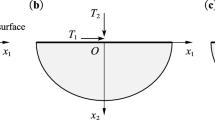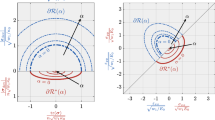Abstract
Sanders showed in 1960, within the framework of two-dimensional elasticity, that in any body a certain integral I around a closed curve containing a crack is path-independent. I is equal to the rate of release of potential energy of the body with respect to crack length. Here we first derive, in a simple way, Sanders' integral I for a loaded elastic body undergoing finite deformations and containing an arbitrary void. The strain energy density need not be homogeneous nor isotropic and there may be body forces. In the absence of body forces, for flat continua, and for special forms of the strain energy density, it is shown that I reduces to the well-known vector and scalar path-independent integrals often denoted by J, L, and M.
Similar content being viewed by others
References
O. D. Kellogg, Foundations of Potential Theory, Springer-Verlag, Berlin, 1929. (Reprinted, Dover Publication, New York, 1953.)
J. D. Eshelby, “The Continuum Theory of Lattice Defects”, Solid State Physics, edited by F. Seitz & D. Turnbull, Volume 3, Academic Press, New York, 1956, pp. 79–144.
J. R. Rice, “A Path-Independent Integral and the Approximate Analysis of Strain Concentrations by Notches and Cracks”, Journal of Applied Mechanics, Volume 35 (1968), pp. 379–386.
W. Günter, “Über einige Randintegrale der Elastomechanik”, Braunschweigische Wissenschaftliche Gesellschaft Abhandlunger, Volume 14, (1962), pp. 53–72.
G. P. Cherepanov, “Crack Propagation in Continuous Media”, Journal of Applied Mathematics and Mechanics, Volume 31 (1967), pp. 503–512.
J. K. Knowles & E. Sternberg, “On a Class of Conservation Laws in Linearized and Finite Elastostatics”, Archive for Rational Mechanics and Analysis, Volume 44 (1972), pp. 187–211.
B. Budiansky & J. R. Rice, “Conservation Laws and Energy-Release Rates”, Journal of pplied Mechanics, Volume 40 (1973), pp. 201–203.
A. E. Green, “Some General Formulae in Finite Elastostatics”, Archive for Rational Mechanics and Analysis, Volume 50 (1973), pp. 73–80.
J. D. Eshelby, “The Elastic Energy-Momentum Tensor”, Journal of Elasticity, Volume 5 (1975), pp. 321–335.
P. Chadwick, “Applications of an Energy-Momentum Tensor to Non-Linear Elastostatics,” Journal of Elasticity, Volume 5 (1975), pp. 249–258.
F. H. K. Chen & R. T. Shield, “Conservation Laws of Elasticity of the J-Integral Type”, Zeitschrift für Angewandte Mathematik und Physik, Volume 28 (1977), pp. 1–22.
J. L. Sanders, Jr., “On the Griffith-Irwin Fracture Theory”, Journal of Applied Mechanics, Volume 27 (1960), pp. 352–353.
J. W. Nicholson & J. G. Simmonds, “Sanders' Energy-Release Rate Integral for Arbitrarily Loaded Shallow Shells and Its Asymptotic Evaluation for a Cracked Cylinder”, Journal of Applied Mechanics, Volume 47 (1980), pp. 363–369.
C. Truesdell & R. Toupin, “The Classical Field Theories”, Handbuch der Physik, Volume III/1, Springer-Verlag, Berlin-Göttingen-Heidelberg, 1960.
Author information
Authors and Affiliations
Additional information
Communicated by E. Sternberg
Rights and permissions
About this article
Cite this article
Simmonds, J.G., Nicholson, J.W. On Sanders' energy-release rate integral and conservation laws in finite elastostatics. Arch. Rational Mech. Anal. 76, 1–8 (1981). https://doi.org/10.1007/BF00250798
Received:
Issue Date:
DOI: https://doi.org/10.1007/BF00250798




